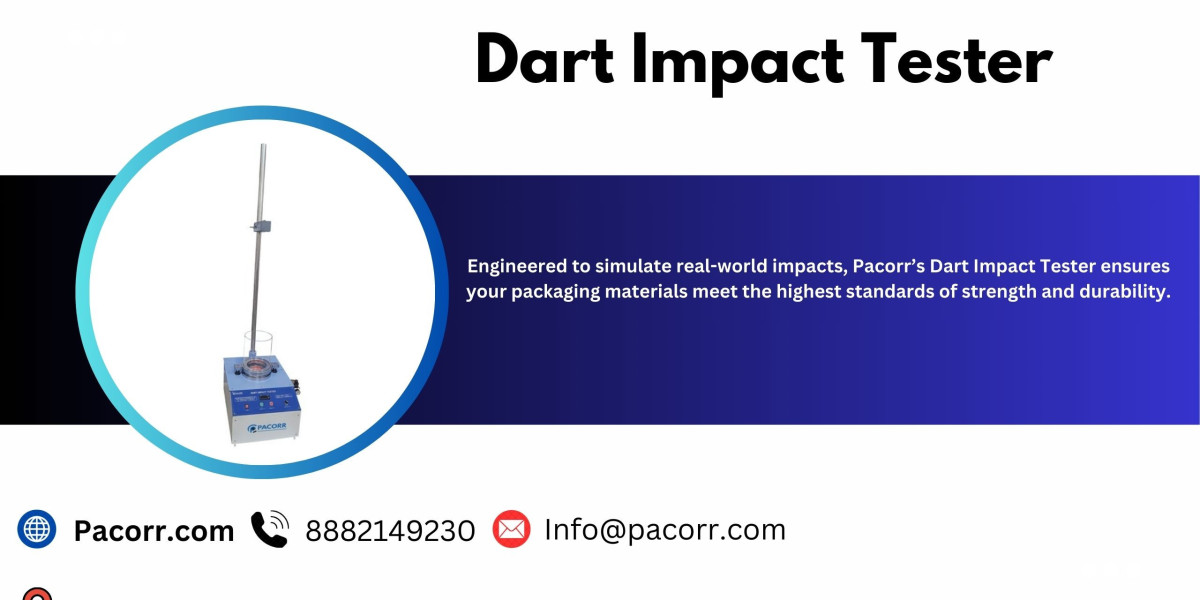By simulating real-world conditions, it helps manufacturers assess how well their packaging can protect their products from external forces during transit.
What is Dart Impact Testing?
Dart Impact Testing involves measuring the ability of a material to resist sudden impacts. This is particularly important for packaging materials, which must endure physical stress during shipping and handling. The test involves dropping a weighted dart from a fixed height onto the material sample. The force generated by the dart upon impact is then calculated, and the material's response is observed. Materials may crack, deform, or puncture based on the intensity of the impact.
This test is often used for flexible materials like plastic films, sheets, and thin foils that are commonly used in packaging. The results provide manufacturers with valuable insights into how a material will perform under impact, helping them make informed decisions about material selection and packaging design.
How Dart Impact Testing Works
The Dart Impact Tester is designed to drop a dart from a specific height onto a material sample. The process is straightforward, yet the results are highly informative. Here’s a step-by-step breakdown of how Dart Impact Testing works:
Preparation: The material to be tested is cut into a specific size, usually a square or rectangular sample. This ensures uniformity in testing across different materials.
Dart Selection and Setup: A dart of a specific weight is selected for the test. The height from which the dart will fall is also set according to industry standards or the testing requirements.
Impact Simulation: The dart is dropped from the set height onto the material sample. Upon impact, the material’s response is carefully observed. The test measures the amount of energy transferred from the dart to the material.
Results and Analysis: The material’s response is analyzed to determine whether it cracks, punctures, or deforms. The energy level required for damage is recorded and used to assess the material’s overall resistance to impact.
Why is Dart Impact Testing Crucial for Packaging?
Dart Impact Testing plays a critical role in ensuring that packaging materials meet the durability requirements for safe product transport. Packaging is designed to protect products from external impacts, but materials can often fail when exposed to stress. The Dart Impact Test mimics real-world conditions where packaging may be dropped, bumped, or handled roughly during shipping.
Packaging materials that pass this test provide manufacturers with assurance that their products will remain protected from damage, whether they are fragile electronics, perishable food, or sensitive pharmaceuticals. For businesses, using the right material means avoiding costly product damage, recalls, and customer dissatisfaction.
Key Benefits of Dart Impact Testing
Improved Material Durability
Dart Impact Testing helps manufacturers select packaging materials that offer the best resistance to impact. By determining how a material absorbs shock and force, manufacturers can choose materials that are more likely to withstand the physical stresses they will encounter.Optimized Material Selection
Not all packaging materials perform the same under stress. Dart Impact Testing allows manufacturers to test and compare various materials, helping them choose the best options for their packaging needs. Whether for thin plastic films, foils, or textile-based materials, this test provides data to make the best material decisions.Ensuring Product Protection
The main purpose of packaging is to protect the product. Dart Impact Testing helps ensure that materials can provide that protection. For products that may face rough handling or harsh transportation conditions, this test ensures that the packaging can absorb impacts without failing.Regulatory Compliance
Different industries have strict regulations for packaging, especially when it comes to protecting sensitive products like pharmaceuticals and food. Dart Impact Testing ensures that packaging materials meet required standards, helping manufacturers remain compliant with industry rules and avoid penalties.Cost Efficiency
Testing materials before production begins saves manufacturers money by avoiding the use of unsuitable materials. Dart Impact Testing allows manufacturers to spot weak points in packaging before mass production, which can save time and reduce waste. This proactive testing prevents costly material failures and product damage in the future.
Applications of Dart Impact Testing
The Dart Impact Tester is widely used across various industries, especially where packaging plays a key role in product protection. Some of the key industries and applications include:
Food Packaging
Food packaging is often made from thin, flexible films that need to be strong enough to protect the contents during shipping and handling. Dart Impact Testing Price ensures that food packaging can withstand rough handling and still maintain its integrity.Pharmaceutical Packaging
Pharmaceuticals require protective packaging that maintains product safety and integrity. Dart Impact Testing is used to ensure that materials for pharmaceutical packaging are strong enough to prevent damage during transportation, particularly for items like medicines and medical devices.Electronics Packaging
Fragile electronics such as smartphones, tablets, and computer components need packaging that can absorb shocks and impacts. Dart Impact Testing is crucial for determining whether the packaging can protect these delicate items from damage.Industrial Packaging
Industrial products, including machinery and parts, are often shipped under harsh conditions. Dart Impact Testing helps ensure that the packaging materials are strong enough to withstand rough handling during transit.Textile Packaging
Textile products such as bags, sacks, and wraps are commonly used for packaging. Dart Impact Testing evaluates whether these materials can resist punctures and tears during handling and shipping.
Advanced Features of Dart Impact Testers
Modern Dart Impact Testers come equipped with several advanced features that make them more efficient and accurate:
Automated Testing: Automated Dart Impact Testers ensure consistent results with minimal human intervention. They offer faster testing and more accurate data recording, which is particularly useful in large-scale production environments.
Customizable Parameters: Some Dart Impact Testers allow users to adjust parameters such as the height of the dart drop and the weight of the dart. This flexibility allows the test to be tailored to meet specific material and product requirements.
Data Logging and Analysis: Many modern testers come with built-in data logging capabilities, enabling manufacturers to store test results for future analysis. This feature allows for easy tracking of material performance over time.
User-Friendly Interfaces: Many testers now include intuitive touchscreen interfaces and software that makes operation easy, even for less experienced users. The test results are often displayed in real-time, making it easier to interpret and record data.
Conclusion
In the competitive world of manufacturing and logistics, protecting products from damage during shipping and storage is a top priority. The Dart Impact Tester provides manufacturers with the tools they need to ensure their packaging materials meet durability standards, preventing costly product failures and maintaining customer satisfaction.
By simulating real-world impact scenarios, Dart Impact Testing helps companies make informed decisions about material selection, ensuring that their products are packaged with the most resilient materials available. Whether it’s food packaging, pharmaceuticals, electronics, or industrial products, the Dart Impact Tester is a vital tool that provides the confidence manufacturers need to deliver high-quality products safely and securely.






